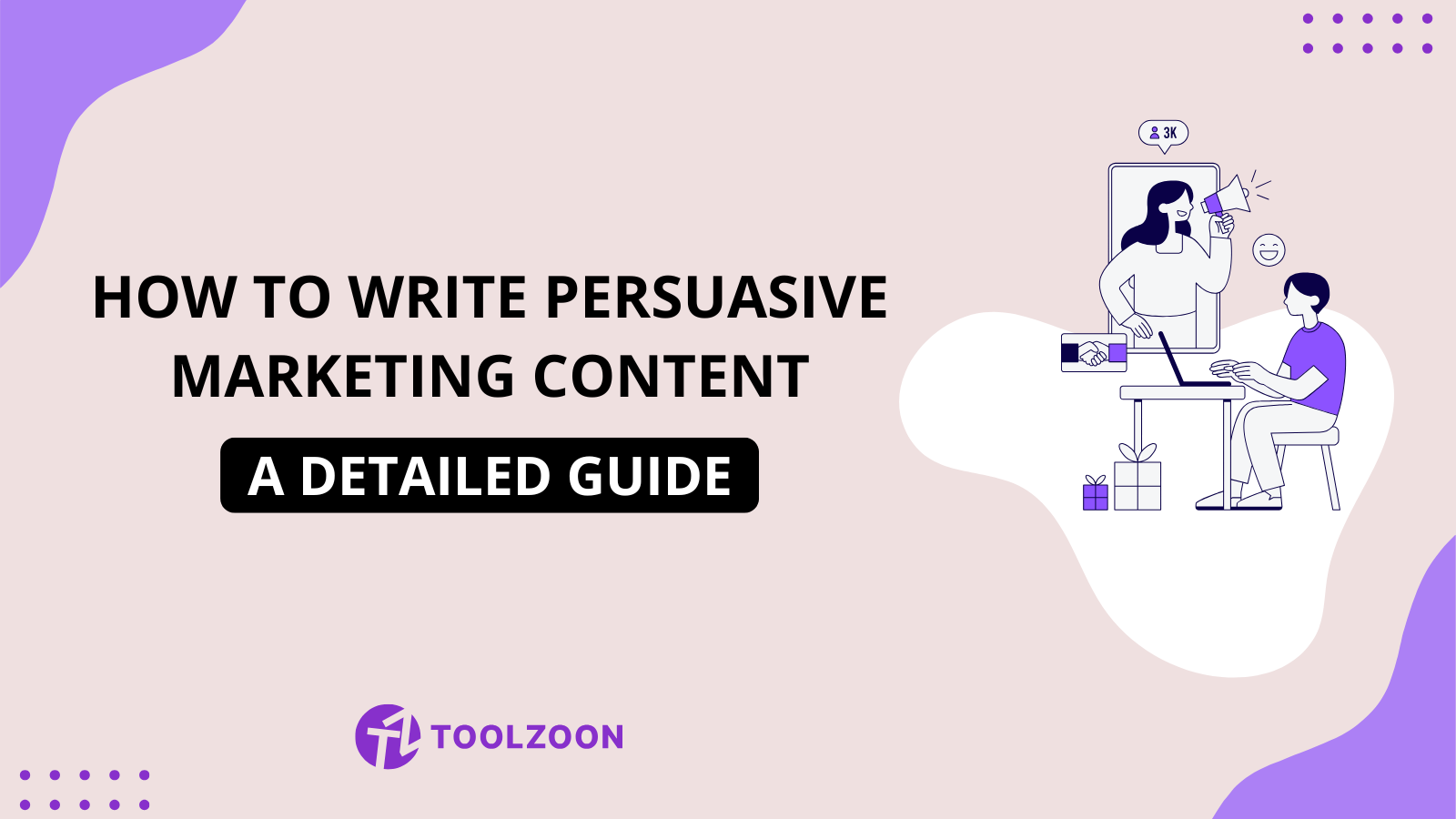How to Write Persuasive Marketing Content: A Detailed Guide

For writing effective marketing content, persuasion holds key importance. You should know to use natural emotions to grab the reader's attention. It's not simple, but an art that requires a lot of time and effort to master. You need to write in such a way that helps convince as well as build strong relations with your readers.
Do you know how to craft such compelling content for marketing purposes?
If you follow a strategic plan, it's not as difficult as it seems. It’s content that builds confidence, evokes emotion, and drives conversion, and if you follow modern marketers strategies, you can easily write it.
For businesses, persuasive marketing content is the base of successful campaigns, emails, and landing pages. With that, authenticity in content is another prime factor that helps consumers stick to some specific brand.
In this guide, we will describe what persuasion is and how it helps craft actionable marketing content. Read on to explore further!
Overview of Persuasive Marketing Content
Content that is written to influence how consumers think, feel, and act and achieve some specific goals is persuasive marketing content. It includes comprehensive information about a specific product or service that guides the audience to engage or perform an action.
If we further study persuasion, we see that Aristotle was the one who introduced how you can make an argument more engaging. He described three persuasion principles that can be applied in writing marketing content, and these are:
- Ethos: It means you should build credibility and trust to convince others.
- Pathos: To improve your engagement rate, bring emotions in your words that resonate with your audience's feelings, desires, or fears.
- Logos: Use logical and trustworthy facts, data, and statistics with links to them.
These principles remain so influential that they're still taught in modern communication courses, as evidenced by Purdue University's Online Writing Lab (OWL), one of the most trusted writing resources online."
So, you need to include human psychology, storytelling, and facts to make the message strong and convincing. This sort of content is mostly used in ads, websites, social media, and emails.
Four Key Elements of Persuasive Marketing Content
To craft an effective marketing content, you need to integrate four elements into your message to make it credible, and these are:
- Start with a Strong Hook: Use words that trigger, social proof, and emotional appeal to influence your audience.
- Address Reader Pain Points: Focus on highlighting a specific problem your readers are facing.
- Provide Solutions: Focus on solving the problems by connecting with readers on an emotional level.
- Use Strong Calls to Action (CTA): Inspire readers to perform actions like "Order Now", "Add to Cart", etc.
Step-by-Step Guide to Write Persuasive Marketing Content
Follow these steps to craft a persuasive marketing content:
1. Define Your Audience
First, know which people you are going to write for. Understand their demographics like:
- What is their age?
- Where do they live?
- What is their education status?
- What main challenges are they facing?
Also, wear the shoes of your targeted audience to understand their needs further. After you get answers to these questions, it becomes easy for you to start writing content that solves their specific issues.
For Example:
"If you sell writing services, your audience can include marketing experts, SEO professionals, business owners, e-commerce brands, and website owners."
2. Write a Compelling Headline
The first thing that creates an impact on the reader is the headline of any marketing content. There are two scenarios: your headline can be interesting or boring. The choice is yours. We have heard that the first impression is the final one. So, if the headline doesn’t grab attention, people won’t read it. To make a headline effective, you can:
- Use Numbers:“10 Proven Ways to Boost Your Sales”
- Ask a Question:“Struggle to Convert Leads? Here’s How to Fix It”
- Create Curiosity:“The Secret to Writing a Copy That Sells”
3. Write a Powerful Hook
The first or opening line of any content is the hook, and it should grab the attention of the audience. You can start your content with:
- A question.
- A stunning fact, like a statistic, etc.
- A problem with a solution.
- A story.
But, make sure that this line is informative, relevant to your topic, grabs attention, and encourages further reading. It is the defining line for your audience engagement and therefore should be written carefully.
For Example:
Different brands see 3x more engagement rates when they use AI-powered writing tools.
Don’t get left behind!
Enhance your introduction lines with an AI hook sentence generator.
4. Sell Benefits, Not Features
It is important to know that customers want to know more about what they benefit from your mentioned product or service than its features. Features only tell what a product does (specifications), but benefits explain why it matters to the customer. Do you know why to focus more on benefits? Here is the answer:
- Creates an emotional connection:Customers relate more to how a product helps them than to its technical details.
- Simplifies decision-making: Benefits clarify why a product is valuable.
- Increases conversions:Customers are more likely to buy when they see how a product meets their needs.
For Example:
Feature: "Our AI blog writer creates informative blog posts in minutes."
Benefit: "Before AI blog writer, I used to spend hours writing and optimising articles. But now, I get SEO-friendly content quickly, which saves a lot of effort and time"
5. Social Proof
Social proof is one of the most persuasive marketing techniques. It helps win the trust of potential buyers, who look to others to guide their decisions, mainly when uncertain. Trust eliminates all hurdles and motivates customers to convert and remain engaged with the brand in the future. Without it, it is hard to convince customers. Here are some types of social proof that you can add while writing marketing content:
- Testimonials or feedback
- Endorsements from experts
- Case studies
- Star ratings
- Highlight affiliated brands
Do you know why social proofs work? Well, the simple answer is that people follow the crowd. If many people approve of something, they think it must be good. Similarly, positive social reviews make potential customers feel less hesitant to commit.
For Example:
If a YouTube video has more than 100K views while another hasn't, most people will assume the first video has better content than the second one. The same logic applies to brands and products online.
Want to write top-notch scripts for YouTube and other platforms?
6. Use Emotional Triggers with a Clear CTA
When people purchase, there is an association of feelings or emotions that help people perceive value and respond to marketing messages. These emotions can create a strong connection with the audience.
Similarly, a clear call to action or CTA helps turn the already-built emotional connection of users into immediate action. It helps create urgency, uplift desires, drive quick action, and increase conversions. You can combine emotional triggers and CTAs to create a powerful sales-driving strategy.
For Example:
FOMO (Fear of Missing Out): “Only 3 spots left—act now!”
Trust:“500,000+ users trust our AI tool.”
Joy: “Unlock your full lead generation potential today”
Empathy:“Struggling with content? Let AI help”
Aspiration:“Dress like a CEO. Shop our premium collection today”
7. Use Storytelling
To make your brand voice memorable, it is great to use storytelling in your marketing content. Don't just say that this product is good but tell it in a story. For this, you can share a real experience, a success story, etc. connect people on an emotional stage, and build trust. Also, it helps them remember your brand message as well as compel readers to take action.
Pro Tip: Use the AI story generator to craft compelling stories that help connect with your audience.
Revolutionize your storytelling game with our free AI Story Generator
8. Optimize for Search Engine
To rank well on search engines, mainly Google, you need to incorporate your primary keyword in it naturally. The places in which you must fit the primary keyword are:
- Headline or title
- First paragraph
- Subheadings like H2, H3
Further, you can use LSI or relevant keywords in your marketing content to improve SEO. Also, for better engagement, you should write long-form content of 500+ words and clear formatting (headings, bullet points). Google algorithms update consistently ,and to stay out of the competition, follow these as well as update your content regularly.
Pro Tip: You can use AI tools like, AI blog writer, meta description generator, etc. to create compelling and SEO optimized content in seconds.
Conclusion
Writing persuasive marketing content is more than just words. You should know the importance of each word, as it serves a purpose. First, know your audience's needs, then make a strategic plan that addresses their pain points and offers authentic solutions. Moreover, your content should influence the reader's decisions, raise emotions, and build trust.
Whether you are going to write ad copy, social media posts, or landing pages, put the discussed techniques into practice, and create content that helps readers engage as well as drive action.
So, what are you waiting for?
Transform your marketing content writing game into a powerful sales asset today.
FAQs
1. What is persuasive marketing content?
A writing piece that forces people to think, feel, or act and helps brands build trust and drive action.
2. What makes marketing content persuasive?
An impactful hook line, problem discussion, solution to that problem, storytelling, social proof, and strong CTAs make content persuasive.
3. What are Aristotle’s persuasion postulates?
He described Ethos (credibility), Pathos (emotion), as well as Logos (logic) as the core persuasion postulates.
4. Does storytelling matter while writing marketing content?
Yes. Stories make content relatable, memorable, and more convincing than plain facts.
5. How can you optimize marketing content for SEO?
Add your focus keyword in the title, headings H2, H3, and the first paragraph naturally. Also, add LSI keywords, bullet points, and tables, and write 500+ words for good engagement.
Explore Other Blogs

How AI Writing Tools Help Enhance Your Productivity: A Comprehensive Guide


Words That Rhyme - Find the Perfect Rhymes Easily




